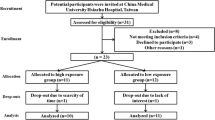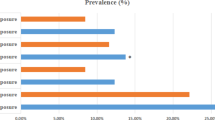Summary
A detailed analysis of risk factors for the development of sensory-neural hearing loss (SNHL) was carried out on 122 forest workers. These forest workers were selected from a larger group (n = 217) by restricting the age range to 30–55 years. The hearing threshold of the left ear at 4000 Hz was measured and the effect of age, exposure, systolic and diastolic blood pressure (DBP), presence of vibration-induced white finger (VWF), tobacco smoking and use of earmuffs were evaluated in multiple linear regression analysis. Robinson's nonlinear model was used to evaluate the rate of hearing loss. Aging was the major risk factor and it explained 15.4% of the variance of the SNHL. The presence of VWF was the second most important single risk factor and explained a further 5.2% of the SNHL. Elevation of DBP correlated significantly with SNHL and explained an additional 4.1% of the SNHL. These main factors were able to explain about 26% of the spread of SNHL. Additional factors in the analysis, e.g. smoking, systolic blood pressure, did not significantly contribute to the genesis of SNHL. When Robinson's model was applied to the SNHL data, on a group basis, we did not observe any exaggerated risk of hearing loss due to combination of noise and vibration. In combined exposure subjects with VWF as well as subjects with enhanced DBP will run a higher risk for SNHL.
Similar content being viewed by others
References
Abrahamsson DI (1967) Circulation in the extremities. Academic Press Inc, New York, p 557
Alberti PW (1982) Personal hearing protection in industry. Raven Press, New York, 605 pp
Andrén L, Hansson L, Björkman M, Jonsson A (1980) Noise as a contributory factor in the development of elevated arterial pressure. Acta Med Scand 207:493–498
Axelsson A, Lindgren F (1978) Temporary threshold shift after exposure to pop music. Scand Audiol 7:127–135
Borg E (1982) Noise-induced hearing loss in normotensive and spontaneously hypertensive rats. Hearing Res 8:117
Burns W, Robinson DW (1970) Hearing and noise in industry. H.M.S.O., London
Chung DY, Willson GN, Gannon RP, Mason K (1982) Individual susceptibility to noise. In: Hamernik RP, Henderson D, Salvi R (eds) New perspectives on noise-induced hearing loss. Raven Press, New York, pp 511–519
Drettner B, Hedstrand H, Klockhoff I, Svedberg A (1975) Cardiovascular risk factors and hearing loss. Acta Otolaryngol (Stockh) 79:366–371
Erdreich J, Erdreich LS (1982) Epidemiologic strategies to understanding noise-induced hearing loss. In: Hamernik RP, Henderson D, Salvi R (eds) New perspectives on noise-induced hearing loss. Raven Press, New York, pp 439–460
Friedman GD, Siegelanb AB, Seltzer CC (1969) Cigarette smoking and exposure to occupational hazards. Am J Epidemiol 98:175–183
Guignard JC, Coles RRA (1965) Effects of infrasonic vibration on the hearing. Fifth Int Congr of Acoustics, Liège
Hamemik RP, Henderson D, Coling D, Slepecky N (1980) The interaction of whole body vibration and impulse noise. J Acoust Soc Am 67:928–934
Hamernik RP, Henderson D, Coling D, Salvi R (1981) Influence of vibration on asymptomatic threshold shift produced by impulse noise. Audiol 20:259–269
Hawkins JE (1973) Comparative otopathology: aging, noise and ototoxic drugs. Adv Otorhinolaryngol 20:125–141
Hempstock TJ, O'Connor DE (1975) The measurement of hand-arm vibration. In: Taylor W, Pelmear PL (eds) Vibration white finger in industry. Academic Press, New York, pp 111–112
Hinchcliffe R (1973) Epidemiology of sensori-neural hearing loss. Audiol 12:446–452
Hinchcliffe R, Littler TS (1958) Methodology of air conduction audiometry for hearing surveys. Ann Occup Hyg 1:114–128
Hultcrantz E (1979) The effect of noise on cochlear blood flow in the conscious rabbit. Acta Physiol Scand 106:29–37
Iki M, Kurumatani N, Hirata K, Moriyama T, Itoh J, Arai T (1986) An association between vibration-induced white fingers and hearing loss in forestry workers. Scand J Work Environ Health 12:365–370
ISO/DIS 1999.2 (1985) Draft international standard. Acoustics-determination of occupational noise exposure and estimation of noise-induced hearing impairment. International Organization for Standardization, p 9
ISO 5349 (1986) International standard. Guidelines for the measurement and the assessment of human exposure to hand-transmitted vibration. International Organization for Standardization, p 13
Johnsson A, Hansson L (1977) Prolonged exposure to a stressful stimulus (noise) as a cause of raised blood pressure in man. Lancet I:86–87
Kaimio M, Jauhiainen T, Kohonen A, Tarkkanen J (1970) Whole body infrasonic vibration effects on the cochlea. Environ Res 3:425–429
Keeler JS (1976) Models for noise-induced hearing loss. In: Henderson D, Hamernik RP, Dosanjh DS, Mills JH (eds) Effects of noise on hearing. Raven Press, New York, pp 361–381
Lawrence M (1980) Control mechanisms of inner ear microcirculation. Am J Otolaryngol 1:324–333
McCormic JG, Harris DT, Hartley CB, Lassiter RBH (1982) Spontaneous genetic hypertension in the rat and its relationship to reduce cochlear potentials: implications for preservation of human hearing. Proc Natl Acad Sci (USA) 79:2668
Okada A, Miyake H, Yamamura K, Minami M (1972) Temporary hearing loss induced by noise and vibration. J Acoustic Soc Am 51:1240–1248
Pinter I (1973) Hearing loss of forest workers and of tractor operators (interaction of noise with vibration). Proc Int Congr on noise as a public health problem. Arlington, Virginia 18 May 1973. The USA Environmental Protection Agency, Office of Noise Abatement and Control, Washington, pp 315–327
Pyykkö I, Färkkilä M, Toivanen J, Korhonen O, Hyvärinen J (1976) Transmission of vibration in the hand-arm system with special reference to changes in compression force and acceleration. Scand J Work Environ Health 2:87–95
Pyykkö I, Hyvärinen J, Färkkilä M (1982a) Studies on the etiological mechanism of the vasospastic component of the vibration syndrome. In: Brammer AJ, Taylor W (eds) Vibration effects on the hand and arm in industry. John Wiley and Sons, New York, pp 13–24
Pyykkö I, Hyvärinen J (1973) The physiological basis of the traumatic vasospastic disease: a sympathetic vasoconstrictor reflex triggered by high frequency vibration. Work Environ Health 10:36–47
Pyykkö I, Korhonen OS, Färkkilä MA, Starck JP, Aatola SA (1982b) A longitudinal study of the vibration syndrome in Finnish forestry workers. In: Brammer AJ, Taylor W (eds) Vibration effects on the hand and arm in industry. John Wiley and Sons, New York, pp 157–167
Pyykkö I, Sairanen E, Korhonen O, Färkkilä O, Hyvärinen J (1978) A decreased hand-grip force in the prevalence and severity of vibration-induced white fingers among lumberjacks in Finland. Scand J Work Environ Health 4:246–254
Pyykkö I, Starck J (1982) Vibration syndrome in the etiology of occupational hearing loss. Acta Otolaryngol (Stockh) [Suppl] 386:296–300
Pyykkö I, Starck J, Färkkilä M, Hoikkala M, Korhonen O, Nurminen M (1981) Hand-arm vibration in the aetiology of hearing loss in lumberjacks. Br J Ind Med 38:281–289
Pyykkö I, Starck J, Pekkarinen J (1986) Further evidence of a relation between noise-induced permanent threshold shift and vibration-induced digital vasospasms. Am J Otolaryngol 4:391–398
Robinson DW (1971) Estimating the risk of hearing loss due to continuous noise. In: Robinson DW (ed) Occupational hearing loss. Academic Press, London, pp 43–62
Rosen S, Olin P (1965) Hearing loss and coronary heart disease. Arch Otolaryngol 82:236–243
Rosen S, Plester D, El-Mofty A, Rosen HV (1964) Relation of hearing loss to cardiovascular disease. Trans Am Acad Ophthalmol Otolaryngol 68:433–444
Spencer JT (1975) Hyperlipoproteinemia and inner ear disease. Otolaryngol Clin North Am 8:483–492
Starck J (1984) High impulse acceleration levels in hand-held vibratory levels. An additional factor in the hazards associated with the hand arm vibration syndrome. Scand J Work Environ Health 10:171–178
Starck JP, Aatola SA, Hoikkala MJ (1982) Chain saw vibration: effect of age of the saw and repeatability of measurements. In: Brammer AI, Taylor W (eds) Vibration effects on the hand and arm in industry. John Wiley and Sons, New York, pp 197–202
Starck J, Godenhielm B, Perkio R (1979) Effect of helmet liner on the attenuation of ear-muffs. Proc Inter-Noise 79 Warzova-Poland. September 11–13, pp 877–880
Starck J, Färkkilä M, Aatola S, Pyykkö I, Korhonen O (1983) Vibration syndrome and vibration in pedestal grinding. Br J Ind Med 40:426–433
Stewart RO (1976) The effect of carbon monoxide on humans. J Occup Med 18:304–309
Tachibana M, Yamamichi I, Nakae S, Hirasugi Y, Machino M, Mizukoshi O (1984) The site of involvement of hypertension within the cochlea. Acta Otolaryngol (Stockh) 97:257–265
Taniewski M, Banaszkiewicz T (1973) Hearing in persons exposed to vibration. Biul Inst Med Morskiej w Gdansku 24, 35. In: Sulkowski W (ed) Noise induced permanent threshold shifts: occupational deafness. Estratto dagh atti del congresso internationale l'uomo ed il rumore. Torino 7–10 guigno 1975, pp 121–128
Weston TET (1964) Presbycusis: a clinical study. J Laryngol 78:273–285
Wright MI (1971) Pathology of deafness. Manchester University Press, Manchester
Yokoyama T, Osako S, Yamomoto K (1974) Temporary threshold shifts produced by exposure to vibration, noise and vibration-plus-noise. Acta Otolaryngol (Stockh) 78:207–212
Zelman S (1973) Correlation of smoking history with hearing loss. J Am Med Assoc 223:920
Author information
Authors and Affiliations
Rights and permissions
About this article
Cite this article
Pyykkö, I., Pekkarinen, J. & Starck, J. Sensory-neural hearing loss during combined noise and vibration exposure. Int Arch Occup Environ Heath 59, 439–454 (1987). https://doi.org/10.1007/BF00377838
Received:
Accepted:
Issue Date:
DOI: https://doi.org/10.1007/BF00377838




